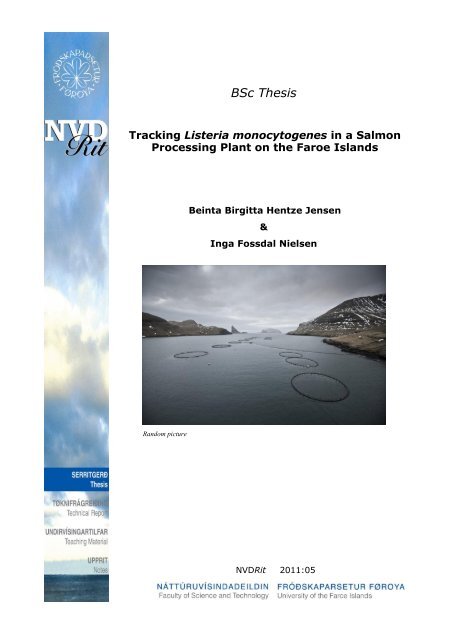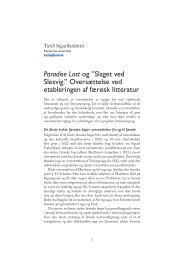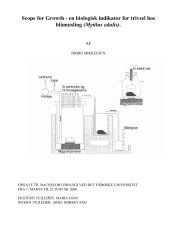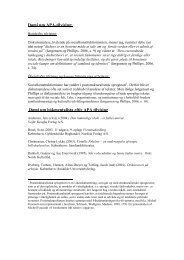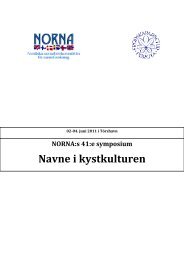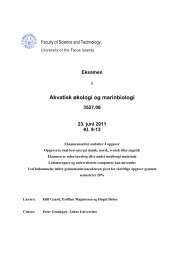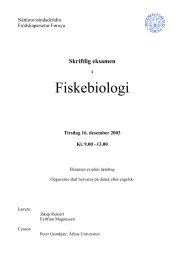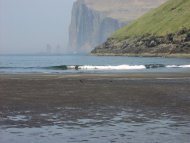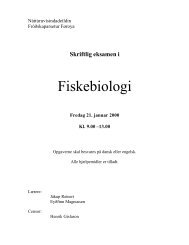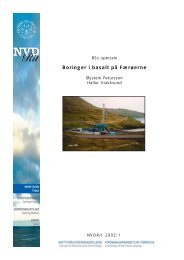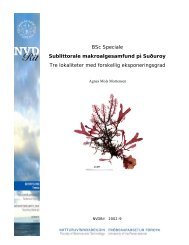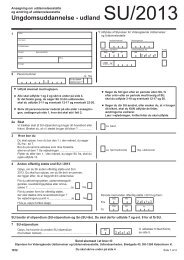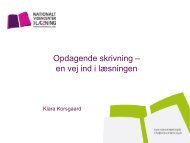Infectious Pancreatic Necrosis Virus (IPNV) - Fróðskaparsetur Føroya
Infectious Pancreatic Necrosis Virus (IPNV) - Fróðskaparsetur Føroya
Infectious Pancreatic Necrosis Virus (IPNV) - Fróðskaparsetur Føroya
Create successful ePaper yourself
Turn your PDF publications into a flip-book with our unique Google optimized e-Paper software.
BSc Thesis<br />
Tracking Listeria monocytogenes in a Salmon<br />
Processing Plant on the Faroe Islands<br />
Random picture<br />
Beinta Birgitta Hentze Jensen<br />
&<br />
Inga Fossdal Nielsen<br />
NVDRit 2011:05
Heiti / Title Tracking Listeria monocytogenes in a Salmon<br />
Processing Plant on the Faroe Islands<br />
Kanningar av slóðini hjá bakteriuni Listeria<br />
monocytogenes á einum laksa virki í Føroyum.<br />
Høvundar / Authors Beinta Birgitta Hentze Jensen & Inga Fossdal<br />
Nielsen<br />
Vegleiðari / Supervisor Jógvan Páll Fjallsbak, Heilsufrøðiliga Starvsstovan<br />
Debes H. Christiansen, Heilsufrøðiliga Starvsstovan<br />
Ábyrgdarvegleiðari / Responsible Supervisor Svein-Ole Mikalsen, <strong>Fróðskaparsetur</strong> <strong>Føroya</strong><br />
Ritslag / Report Type BSc ritgerð, lívfrøði<br />
BSc Thesis, Biology<br />
Latið inn / Submitted 10. juni 2011<br />
NVDRit 2011:05<br />
© Náttúruvísindadeildin og høvundarnir 2011<br />
ISSN 1601-9741<br />
Útgevari / Publisher Náttúruvísindadeildin, <strong>Fróðskaparsetur</strong> <strong>Føroya</strong><br />
Bústaður / Address Nóatún 3, FO 100 Tórshavn, <strong>Føroya</strong>r (Faroe Islands)<br />
@ +298 352 550 +298 352 551 nvd@setur.fo
Abstract<br />
Listeria monocytogenes is a natural environmental bacterium and a serious pathogen causing<br />
the disease listeriosis in humans. Salmon processing plants have frequently been found to be<br />
contaminated with L. monocytogenes. However little is known about where in the production<br />
pathway contamination of L. monocytogenes occurs.<br />
To establish where in the production pathway contamination of L. monocytogenes occurred,<br />
we examined one salmon producing plant for L. monocytogenes on the Faroe Islands. This<br />
was done by taking seawater samples both by the marine aquacultures and at the harvesting<br />
sites. Swab samples were also taken in the harvesting and processing plants, and from fish<br />
from both plants. Positive L. monocytogenes samples were found both in the seawater and in<br />
the processing plant. We found positive samples all way through the production pathway.<br />
We used multilocus sequence typing (MLST) of 6 genes to determine the genetic link<br />
between the different L. monocytogenes isolates from seawater and the processing plant.<br />
Findings indicate that the main source of L. monocytogenes contamination could be the<br />
seawater coming into the plant via the fish.<br />
Samandráttur<br />
Listeria monocytogenes er ein natúrlig umhvørvis bakteria og ein sjúkuelvandi bakteria, ið<br />
elvir til álvarsligu sjúkuna listeriosu hjá menniskjum. Virkir ið viðgera laks hava javnan verið<br />
dálkaði við L. monocytogenes. Kortini veit man lítið um hvaðani í framleiðslu leiðini<br />
dálkingin av L. monocytogenes fer fram.<br />
Vit hava kannað eitt virkið í Føroyum fyri L. monocytogenes, fyri at staðfesta hvaðani í<br />
framleiðsluleiðini dálking av L. monocytogenes fer fram. Hettar varð gjørt við at taka sjógv<br />
sýni bæði við aliringarnar og við tøkuringin. Svabara sýnir vóru eisini tikin á blóðgistøðini, á<br />
virkinum og frá fiski frá báðum støðunum. Positiv L. monocytogenes sýni vóru funnin bæði í<br />
sjónum og á virkinum. Vit funnu sostatt positiv sýni gjøgnum alla framleiðsluleiðina.<br />
Vit brúktu “multilocus sequence typing” (MLST) av 6 genum fyri at avgera arva liðin millum<br />
tær ávísu L. monocytogenes. MLST vísti tættan arva lið millum L. monocytogenes isolerað frá<br />
sjógvi og á virkinum, ið bendir á at L. monocytogenes dálking kundi komi frá sjónum og inn á<br />
virkið við fiskinum.<br />
2
Content<br />
1 Introduction .................................................................................................................................. 4<br />
1.1 Background .............................................................................................................................................. 4<br />
1.2 Problem Statement .................................................................................................................................. 5<br />
1.3 Experimental Design ............................................................................................................................... 5<br />
1.3.1 Description of the Processing Plant........................................................................................................ 6<br />
1.3.2 Sampling Coverage ................................................................................................................................ 6<br />
2 Theories ......................................................................................................................................... 8<br />
2.1 Listeria monocytogenes and Listeriosis .................................................................................................. 8<br />
2.1.1 Listeria monocytogenes .......................................................................................................................... 8<br />
2.1.2 Listeriosis ............................................................................................................................................... 9<br />
2.1.3 Listeriosis Caused by Food .................................................................................................................. 10<br />
2.1.4 Trade Problems .................................................................................................................................... 11<br />
2.2 Appearance of Listeria monocytogenes in Food, Especially Fish ...................................................... 12<br />
2.3 Occurrence of Listeria monocytogenes in Seawater ............................................................................ 14<br />
2.4 Occurrence and Tracking of Listeria monocytogenes in Production ................................................ 16<br />
2.5 Persistency and Control of Listeria monocytogenes ............................................................................ 16<br />
3 Methods ....................................................................................................................................... 18<br />
3.1 Samples................................................................................................................................................... 18<br />
3.1.1 Materials ............................................................................................................................................... 18<br />
3.1.2 Samples: Production Equipment, Raw Material, Manufactured Goods and Seawater Samples .......... 18<br />
3.2 Listeria monocytogenes Identification .................................................................................................. 19<br />
3.2.1 Listeria monocytogenes Enrichment .................................................................................................... 19<br />
3.2.2 Listeria monocytogenes Isolation ......................................................................................................... 19<br />
3.2.3 Listeria monocytogenes Identification ................................................................................................. 20<br />
3.3 Multilocus Sequence Typing (MLST) of Listeria monocytogenes ..................................................... 20<br />
3.3.1 Phylogenetic Analysis using ClustalX and TreeView.......................................................................... 21<br />
4 Results .......................................................................................................................................... 22<br />
5 Discussion .................................................................................................................................... 26<br />
6 Conclusion ................................................................................................................................... 31<br />
7 Perspective ................................................................................................................................... 32<br />
8 References.................................................................................................................................... 33<br />
9 Appendix ..................................................................................................................................... 38<br />
3
1 Introduction<br />
1.1 Background<br />
Listeria monocytogenes was first described by Murray et al. (1926) in 1924. The organism<br />
was isolated from rabbits and guinea pigs.<br />
L. monocytogenes is a Gram-positive bacterium that occurs widely in both agricultural (soil,<br />
vegetation, silage, faecal material, sewage, and water), aquacultural, and food processing<br />
environments (Fenlon 1999). L. monocytogenes is a transitory resident of the intestinal tract in<br />
humans, with 2 to 10% of the general population being carriers of the microorganism without<br />
any apparent health consequences (Farber & Peterkin 1991 and CAC 2007).<br />
L. monocytogenes is an opportunistic pathogen which can cause the bacterial infection<br />
listeriosis. The disease primarily manifests as sepsis, meningitis or materno-fetal infections<br />
(Anonymous 2010). The likelihood that L. monocytogenes can establish a systemic * infection<br />
is dependent on a number of factors, including the number of microorganisms consumed, host<br />
susceptibility, and virulence of the specific isolate ingested. All strains of L. monocytogenes<br />
appear to be pathogenic (FAO/WHO 2004). Listeriosis is most prevalent in people in certain<br />
risk groups, which include the elderly, newborns, pregnant women and immunocompromised<br />
people (Lundén 2004).<br />
Listeriosis is mainly observed in industrialized countries. It is not known whether these<br />
differences in incidence rates between developed and less developed countries reflect<br />
geographical differences, differences in food habits and food storage, or differences in<br />
diagnosis and reporting practices (FAO/WHO 2004). The total incidence of invasive<br />
listeriosis is estimated to be 2-10 per million population per annum in the countries where<br />
data are available (FAO 1999). Because of the high mortality rate some countries have<br />
introduced a zero-tolerance policy in ready-to-eat products.<br />
Due to the remote location of the Faroe Islands, the Faroese people have for centuries had to<br />
rely on the ocean for food and their livelihoods. Even today, fish represents more than 96% of<br />
the total export. Farmed salmon represents around one third of all export from the Faroe<br />
Islands. No matter where you go on the Faroe Islands, the Atlantic Ocean is always close at<br />
* An infection in which the pathogen is distributed throughout the body rather than concentrated in one area. L.<br />
monocytogenes multiplies intracellularly within the macrophages.<br />
4
hand. The Faroe Islands have 1298 km (807 miles) of coastline, and the farthest away from<br />
the ocean one can get is 5 km (3 miles).<br />
The Faroe Islands are not a part of the EU. However, the Faroe Islands have free trade treaties<br />
in place with the EU with regard to the free movement of goods between the EU and the<br />
Faroe Islands (FFFA). This means that salmon production in the Faroe Islands complies with<br />
all EU regulations and directives. In fact, the EU is the Faroe Islands’ biggest trading partner.<br />
1.2 Problem Statement<br />
The general purpose of this thesis was to examine potential occurrence of Listeria<br />
monocytogenes in a Faroese salmon processing plant, including its processing pathway from<br />
the marine aquaculture environment to the finished product. If any L. monocytogenes was<br />
found in the processing plant, it was of interest to examine whether the bacteria came from<br />
contaminated seawater or if there was an “in house culture” causing L. monocytogenes<br />
contamination. This could be obtained by comparing with old L. monocytogenes positive<br />
samples from the processing plant (2009) with the potential new samples. We would also<br />
investigate whether L. monocytogenes came from abdominal cavity of the fish to indicate if<br />
precautions should be taken after the fish had been eviscerated.<br />
1.3 Experimental Design<br />
Figure 1 shows how the processing takes place.<br />
Figure 1: Schematic design of the harvesting and processing plants. A, B, and C represent the fjords where the<br />
marine aquacultures are situated.<br />
5
1.3.1 Description of the Processing Plant<br />
The processing plant has marine aquacultures situated in different places on the Faroe Islands.<br />
Prior to harvesting the marine aquacultures (marine salmon grow-out cages) are transferred to<br />
the location of the on-shore harvesting plant (the harvesting site) and the fish is pumped from<br />
the seawater into the harvesting plant. Inside the harvesting plant, the fish is stunned and<br />
transported on a conveyor belt to a road tanker. In the road tanker the fish is exsanguinated<br />
(bleeding out). The road tanker then transports the fish to the processing plant. When inside<br />
the processing plant the fish first reaches a large cooling tank, thereafter the fish is eviscerated<br />
and transported into the next cooling tank. A conveyor belt then transports the fish to quality<br />
check where the fish is sorted and graded according to weight. Thereafter the fish is packed<br />
and iced, before it is stored and then sold.<br />
While we where taking samples the harvesting plant was situated in fjord A and the<br />
processing plant in fjord C. The fish was therefore transported in a road tanker from fjord A,<br />
after stunning to fjord C, where it was processed further.<br />
1.3.2 Sampling Coverage<br />
All seawater samples were taken from three harvesting sites, located in different fjords (A, B,<br />
and C) on the Faroe Islands. Reference samples were taken by the marine aquacultures<br />
(surface water just beside the aquacultures). The harvesting and processing plants were also<br />
examined. We wanted to establish if the L. monocytogenes found in the processing plant came<br />
from the seawater or if there was another source of contamination. We also examined two old<br />
L. monocytogenes positive samples taken from the processing plant, to examine if the<br />
processing plant might have an “in house” L. monocytogenes culture.<br />
Appendix 1 shows where the samples were taken and when. In the beginning of this project<br />
we had several L. monocytogenes positive seawater samples taken by the processing plant we<br />
examined. We examined seawater samples over a period of six months, one sample every<br />
month from October 2010 to March 2011. Sampling inside the processing plant was made<br />
over a period over three days.<br />
Day 1 – 6 March 2011: Samples were taken at the harvesting (samples 1-4) and processing<br />
plant (5-15) before production started, to see if the cleaning and disinfection had been<br />
efficient enough.<br />
6
Day 2 – 7 March 2011: Samples were taken about two hours after production started. Both in<br />
the harvesting (samples 16-17) and in the production plant (samples 23-30) Five swabs were<br />
taken from fish (samples 18-22 and 31-35). Meat samples from fish chops were taken in the<br />
production plant (samples 36-38). Seawater was sampled, both by the marine aquaculture<br />
(reference sample), at the harvesting site by the shore were the fish are pumped into the<br />
harvesting plant located in fjord A, and of the seawater that is cleaned and then cooled and<br />
pumped into the road tanker.<br />
Day 3 – 14 April 2011: About five weeks later we decided to take more swab samples in the<br />
processing plant two hours after production. 14 more swab samples were taken (samples 39-<br />
52), including five swabs from fish (samples 47-51).<br />
All samples were tested for L. monocytogenes and if positive, PCR products from six L.<br />
monocytogenes genes were sequenced to determine the bacterial strain.<br />
7
2 Theories<br />
2.1 Listeria monocytogenes and Listeriosis<br />
2.1.1 Listeria monocytogenes<br />
Listeria monocytogenes was first described by Murray et al. (1926) in 1924. The organism<br />
was isolated from rabbits and guinea pigs. Animals infected with L. monocytogenes were<br />
observed to have caught monocytosis. This organism was originally named Bacterium<br />
monocytogenes, and was a few years later reported to be a human pathogen (Lundén 2004).<br />
Currently the genus Listeria contains six species: Listeria monocytogenes, Listeria ivanovii,<br />
Listeria welshimeri, Listeria innocua, Listeria seeligeri and Listeria grayi (Rocourt 1999 and<br />
Hitchins 2011). L. monocytogenes can be divided into 13 serotypes according to somatic (O)<br />
and flagellar (H) antigens (Lundén 2004 and Lund 2008). Table 1 summarizes the 13<br />
serotypes.<br />
Table 1: Serotypes of Listeria monocytogenes (Farber & Peterkin 1991, and Hitchins 2011)<br />
Serotypes<br />
1/2a, 1/2b, 1/2c<br />
3a, 3b, 3c<br />
4a, 4ab, 4b, 4c, 4d, 4e, 7<br />
Listeria monocytogenes is aerobic, microaerophilic, facultative anaerobic, non-spore forming<br />
gram-positive rod and the causative agent of listeriosis (Rocourt 1999). Moreover, due to<br />
peritrichous flagella L. monocytogenes is motile at 20-25 ºC but not at 37 ºC (Hof 1996,<br />
Gründling et al. 2004, and Lund 2008).<br />
The bacterium causes -haemolysis on blood agar (i.e. the bursting of red blood cells due to<br />
bacterial-induced holes in their membranes), with narrow zone of haemolysis around the<br />
colonies (Farber & Peterkin 1991, Hof 1996, and NMKL 2007). As shown in Table 2, L.<br />
monocytogenes is a psychro- and halotolerant organism (Vogel et al. 2001) that grows in a<br />
temperature range from less than 0°C to about 45°C. Its optimal growth is at 30°C to 37°C<br />
(Vogel 2002). L. monocytogenes can grow in a NaCl concentration up to 10 % and survive<br />
20% NaCl concentrations (Wilhelm 2003). Furthermore L. monocytogenes can grow in pH<br />
8
anging from 4 to 9, but optimally between pH 7-8 (Huss et al. 2000, Vogel 2002, and<br />
Wilhelm 2003).<br />
Table 2: Growth limits for L. monocytogenes (FAO 1999)<br />
Environmental Factor<br />
Lower<br />
Limit Upper Limit<br />
Temperature (°C) -0.3 to + 3 ~ 45<br />
Salt (% NaCl, water phase) < 0.5 12-13<br />
pH (HCl as acidulant) 4.2 – 4.3 9.4 – 9.5<br />
2.1.2 Listeriosis<br />
Listeriosis is a bacterial infection caused by the bacterium Listeria monocytogenes. Listeriosis<br />
is a relatively rare food infection that mostly infects elderly, newborns, pregnant women and<br />
immunocompromised people, which include people with organ transplants, alcoholism,<br />
diabetes and human immunodeficiency virus (HIV).<br />
Manifestations of listeriosis include but are not limited to bacteremia, septicemia, meningitis,<br />
encephalitis, miscarriage, neonatal disease, premature birth and stillbirth (CAC 2007). Most<br />
healthy individuals are either unaffected by L. monocytogenes or experience only flu-like<br />
symptoms. The symptoms of listeriosis usually last about 7 to10 days. The most common<br />
symptoms are fever, vomiting and muscle aches. If the infection spreads to the nervous<br />
system it can cause meningitis, an infection of the covering (protective membranes) of the<br />
brain and spinal cord, known collectively as the meninges.<br />
The occurrence of listeriosis is very low in humans. No cases have been reported in Iceland or<br />
on the Faroe Islands since 1997, but in the other Nordic countries from 4 to 8 cases per<br />
million inhabitants have been reported annually (Gudbjörnsdóttir 2004). However, the<br />
mortality rate is between 20-30% (FAO 1999, Rocort et al. 2001, Lundén 2004, and<br />
FAO/WHO 2004). Pregnant women are much more likely to be infected than the rest of the<br />
population. Infected pregnant women may have only mild, flu-like symptoms. However,<br />
infection in a pregnant woman can cross the placenta and gain access to the fetus, leading to<br />
abortion, stillbirth or delivery of an acutely ill baby (Lund 2008).<br />
Incubation period for listeriosis can vary much, from a few days to three months (CAC 2007).<br />
9
From the reported number of Listeria in contaminated food responsible for epidemic and<br />
sporadic food-borne cases, there is little evidence that a very low number of L.<br />
monocytogenes in food could cause listeriosis (Rocourt et al. 2000). Even if research indicate<br />
that low level of L. monocytogenes does not lead to infection, several countries have<br />
established a zero-tolerance, which means that no L. monocytogenes must be detected in a 25g<br />
sample (FAO 1999 and Vogel 2002).<br />
2.1.3 Listeriosis Caused by Food<br />
Listeria monocytogenes has been isolated from foods such as raw vegetables, raw and<br />
pasteurized fluid milk, cheeses (particularly soft-ripened varieties), ice cream, butter,<br />
fermented raw-meat sausages, raw and cooked poultry, raw and processed meats (all types)<br />
and raw, preserved and smoked fish (CAC 2007). Even when L. monocytogenes is initially<br />
present at a low level in contaminated food, the microorganism may multiply during storage<br />
in foods that support growth, even at refrigeration temperatures.<br />
L. monocytogenes is of particular concern in ready-to-eat products in which the bacterium can<br />
multiply. Such foods, or their ingredients, may have received a listericidal treatment (e.g.<br />
pasteurization of milk for cheese production) or cooking, but subsequent processing (e.g.<br />
fermentation and ripening of cheeses, slicing and packaging of cooked meats) may allow a<br />
risk of contamination (Lund 2008). The occurrences of listeriosis over the last 15 years<br />
indicates that some products display greater risk than others. Ready-to-eat products kept at<br />
refrigerator temperature over a longer period of time, are among the products that display a<br />
greater risk, because L. monocytogenes has had opportunity to reproduce and reach infective<br />
doses (Rocourt et al. 2001) as illustrated in Figure 2.<br />
Figure 2. Multiplication of Listeria monocytogenes in<br />
broth at low temperatures (Hof 1996)<br />
10
Modern processing and packaging techniques have enabled production of foods with<br />
extended shelf-lives, and therefore made it difficult to control the L. monocytogenes levels.<br />
Besides the amount of L. monocytogenes present in food the infectious dose of a food-borne<br />
pathogen depends on a number of variables including the condition of the host, the virulence<br />
of the strain, the type and amount of food consumed, and the concentration of the pathogen in<br />
the food (Rocourt et al. 2000).<br />
2.1.4 Trade Problems<br />
There is no international agreement concerning the Listeria monocytogenes problem. Some<br />
countries e.g. USA, Russia, and Italia have established a zero-tolerance policy in ready-to-eat<br />
products (Shank et al. 1996, Onischenko 2001, Wilhelm 2003, and Chen et al. 2007). The<br />
European Commission recommended that it should be an objective to keep the concentration<br />
of L. monocytogenes in food below 100 colony forming units (cfu) per gram and to reduce the<br />
fraction of foods with a concentration above 100 cfu of L. monocytogenes per gram<br />
significantly (EC 1999). Since 2006, the EU Regulation on microbiological criteria has been<br />
in force. The Regulation distinguishes between products supporting growth of L.<br />
monocytogenes and products not supporting growth. All ready-to-eat (RTE) products are<br />
covered and the maximum limit value at the end of shelf-life is 100 cfu/g (EC 1999, EC 2005,<br />
and Anonymous 2010). The Faroe Islands have no strict policy regarding L. monocytogenes.<br />
Other countries have a L. monocytogenes tolerance on less than 100 cfu/g in some provisions.<br />
Regarding fish and fishery products, the dose-response has been estimated by combining data<br />
on the incidence of listeriosis in Germany with data on the levels of L. monocytogenes in<br />
smoked-fish in that country (FAO 1999). It was necessary to make many assumptions, but all<br />
were chosen to result in conservative estimates. Epidemiological and food survey data were<br />
combined, using a predictive modeling approach, to estimate a dose-response relationship for<br />
L. monocytogenes levels and incidence of listeriosis. Two methods were used to model and<br />
calculate the dose-response relationship. Both methods gave a similar result. Using that<br />
approach, for the estimated immunocompromised sub-population of Germany (20% of the<br />
population), the model predicts a 1 in 59 million chance of infection from consumption of a<br />
50g serving of fish containing 100 cfu/g (FAO 1999).<br />
Several studies show that 10-60% of newly manufactured cold-smoked salmon is<br />
contaminated with L. monocytogenes (FAO 1999). Therefore L. monocytogenes detection<br />
11
causes great trade problems, in the countries that have established a zero-tolerance policy.<br />
According to Vogel et al. (2001) it is impossible to produce cold-smoked salmon that is 100%<br />
free of L. monocytogenes.<br />
Salmon from the Faroe Islands is sold almost worldwide. The salmon can be sold to<br />
smokehouses for further processing or it can be sold unprocessed to ordinary citizens through<br />
a fishmonger or fish market.<br />
2.2 Appearance of Listeria monocytogenes in Food, Especially Fish<br />
Listeria monocytogenes is found naturally in many kinds of raw foods e.g. vegetables, milk,<br />
meat and fish (Wilhelm 2003 and Autio 2003). Products, which do not receive any heat<br />
treatment by the consumer i.e. ready-to-eat products, like cheese, meat and fish delicatessen<br />
may contain high levels of L. monocytogenes. High levels of L. monocytogenes compromise a<br />
great health risk for the people in the risk group. Ready-to-eat products include any food<br />
(including beverages) that is normally consumed in its raw state, or any food handled<br />
processed, mixed, cooked or otherwise prepared into a form in which it is normally consumed<br />
without further processing (CAC 1999).<br />
From the reported numbers of L. monocytogenes in contaminated food responsible for<br />
epidemic and sporadic foodborne cases, there is little evidence that a very low number of L.<br />
monocytogenes in food causes listeriosis (FAO 1999). It is considered that the vast majority<br />
of cases have resulted from consumption of high numbers of the bacterium, and foods where<br />
the level of the pathogen was higher than 100 cfu/g (FAO/WHO 2004). Seafood has been<br />
classified according to risk for listeriosis as seen in Table 3.<br />
12
Table 3: Seafood classified according to risk for listeriosis (Rocourt et al. 2000).<br />
High risk Low risk<br />
Molluscs (including fresh and frozen<br />
mussels), clams, oysters (in shell or<br />
shucked)<br />
Heat-processed (sterilised, packed in<br />
sealed containers).<br />
Raw fish Fresh frozen fish and crustaceans.<br />
Lightly preserved fish products (i.e. NaCl<br />
5.0).<br />
This group includes salted, marinated,<br />
fermented, cold-smoked- and gravad fish.<br />
Mildly heat-treated (pasteurized, cooked,<br />
hot smoked) fish products and crustaceans<br />
(including pre-cooked, breaded fillets).<br />
Semi-preserved fish, i.e. NaCl >6% (w/w)<br />
in water phase, or pH
Table 4: Main documented cases of foodborne listeriosis associated with fish and fishery<br />
products (FAO 1999)<br />
Location / No. Clinical<br />
year cases forms1 No. Food cfu/g Serotype<br />
deaths<br />
USA- 1989 2 2 2 2 0 Shrimp NK 4b<br />
Italy – 1989 1 0/1 0 Fish NK 4b<br />
Australia –<br />
1991<br />
New-Zealand<br />
1992<br />
2 0/2 0 Smoked mussels 1 x 10 7 NK<br />
4 4/0 0 Smoked mussels NK 1/2b<br />
Canada – 1996 2 0/2 NK Imitation crab<br />
meat<br />
2 x 109 1/2b<br />
Sweden – 8 3/8 2 gravad/cold- 0 °C), at a<br />
wide pH range (4-9) and in up to 10 % NaCl concentrations. Studies have shown that L.<br />
monocytogenes only has limited growth in naturally infected fish (Huss et al. 2000).<br />
2.3 Occurrence of Listeria monocytogenes in Seawater<br />
Listeria monocytogenes is present in freshwater and in seawater near the coastline. Fecal<br />
contamination from animals and run-off from land may be a significant source of L.<br />
monocytogenes to shellfish and fish. However, unpolluted seawater and ground- or spring<br />
water is free from this organism, and has not been detected in fish from such locations (Huss<br />
et al. 1995).<br />
There only exist few studies of abundance of L. monocytogenes in seawater when it comes to<br />
marine aquaculture of salmon. Ben Embarek et al. (1997) took samples of seawater and<br />
examined them for Listeria. Rørvik et al. (1995) and Wilhelm (2003) sampled seawater near<br />
the slaughterhouse and near shore respectively, and examined it for Listeria (see Table 5).<br />
14
Table 5: Seawater examined for Listeria and Listeria monocytogenes<br />
Sample site<br />
Seawater taken<br />
near a<br />
slaughter-house,<br />
Norway<br />
Seawater taken<br />
by aquaculture,<br />
Norway<br />
Seawater near<br />
shore, where the<br />
fish is before<br />
harvesting,<br />
factory A, Faroe<br />
Islands<br />
Seawater near<br />
shore, where the<br />
fish is before<br />
harvesting,<br />
factory B, Faroe<br />
Islands<br />
Number<br />
of<br />
samples<br />
taken<br />
33<br />
8<br />
6<br />
5<br />
Number of<br />
positive<br />
samples for<br />
Listeria (%)<br />
12 (36)<br />
0<br />
5 (83)<br />
5 (100)<br />
Number of<br />
positive samples<br />
for Listeria<br />
monocytogenes<br />
(%)<br />
3 (9)<br />
-<br />
2 (33)<br />
0 (0)<br />
References<br />
Rørvik et al.<br />
1995<br />
Ben Embarek et<br />
al. 1997<br />
Wilhelm 2003<br />
Wilhelm 2003<br />
The lack of Listeria monocytogenes in unpolluted seawater is confirmed in Table 5 as no<br />
Listeria is found by Ben Embarek et al. (1997) in the samples taken by the aquaculture,<br />
situated in a low populated area outside Bergen, Norway. In contrast, Rørvik et al. (1995) and<br />
Wilhelm (2003) found L. monocytogenes in seawater outside the slaughterhouse, which<br />
presumably was contaminated.<br />
According to Ben Embarek et al. (1997) no studies of the natural occurrence of Listeria in<br />
seawater has been published.<br />
In the seafood processing plants, drains are often found contaminated with L. monocytogenes.<br />
However, the drains are not considered to be a source of the contamination, but rather an<br />
indicator of L. monocytogenes contamination of a processing area (Lundén 2004).<br />
15
2.4 Occurrence and Tracking of Listeria monocytogenes in Production<br />
The subtyping of Listeria monocytogenes isolates offers an approach for investigating the<br />
relatedness of isolates and identifying and tracing the sources of epidemics. Subtyping has<br />
been successfully used in identifying and tracing epidemics of L. monocytogenes caused by<br />
food, and to determine which food caused the epidemic. If L. monocytogenes is found in<br />
finished products, all steps in production can be examined, from raw material and through<br />
processing environment to determine the origin of the contamination. Both phenotyping and<br />
molecular typing methods have been applied in the subtyping of L. monocytogenes isolates. L.<br />
monocytogenes contamination studies have been performed to identify contamination routes<br />
and sites in food processing plants and to gain information on how to prevent product<br />
contamination (Rørvik et al. 1995).<br />
Traditional typing methods like serotyping do not give sufficient information when it comes<br />
to epidemics of L. monocytogenes. Most listeriosis cases are associated with a restricted<br />
number of serotypes: 1/2a (15-25%); 1/2b (10-35%); 1/2c (0-4%); 3 (1-2%); 4b (37-64%) and<br />
4 not b (0-6%) (Farber & Peterkin 1991) but none of the present methods have consistently<br />
identified strains that are nonpathogenic or less virulent (FAO/WHO 2004). The numbers<br />
clearly show that serotypes 1/2a, 1/2b, and 4b have been associated most frequently with<br />
listeriosis in humans (Lund 2008).<br />
2.5 Persistency and Control of Listeria monocytogenes<br />
Listeria monocytogenes can be found in contaminated seawater and in seafood plants (Rørvik<br />
et al. 1995). The bacteria can form biofilm (Faber & Peterkin 1991). This can explain how<br />
many studies have shown persistent L. monocytogenes in the production environment for<br />
years (Vogel et al. 2001).<br />
Cleaning and disinfection is therefore a vital part of the control of L. monocytogenes in the<br />
food industries. Cleaning and disinfection are two complementary processes, whereas none of<br />
them can get a good result on its own (Wilhelm 2003). There are often problems with L.<br />
monocytogenes in equipment that is difficult to dismount when cleaning and disinfecting<br />
(Borlaug 2005). If the cleaning and disinfection are not efficient enough L. monocytogenes<br />
may establish biofilm. Biofilm is an aggregate of microorganisms that adhere to each other on<br />
a surface. These adherent cells are embedded within a self-produced matrix of extracellular<br />
16
polymeric substance (EPS). If biofilm is established in a food processing plant, it creates an<br />
“in house culture” of L. monocytogenes and this continues to contaminate the food produced.<br />
Some studies indicate that L. monocytogenes can be found on the skin and in the abdominal<br />
cavity of fish (Huss et al. 2000). Uncontaminated water can be used to clean fish for L.<br />
monocytogenes, but that results in much water in the drains, and if cleaning with high-<br />
pressure washer L. monocytogenes is spread over the whole factory (Borlaug 2005).<br />
17
3 Methods<br />
We examined one salmon producing company for Listeria monocytogenes. Samples were<br />
taken at the harvesting plant and at the processing plant. Samples were taken of raw material,<br />
seawater, production equipment and manufactured goods. Samples of the production<br />
equipment were taken after cleaning and disinfection, and at least 2 hours after production.<br />
Figure 1 shows how the processing is designed.<br />
3.1 Samples<br />
All samples taken inside the harvesting plant and processing plant were taken as swab<br />
samples. The water samples were taken with 9 litres sterile cans. Fish chops were sampled at<br />
the processing plant and examined for Listeria monocytogenes.<br />
3.1.1 Materials<br />
Swab samples were taken with bio-spo TM (Environmental Sampling Products, Solar<br />
Biological Inc.). After using the swab cloth, it was returned to the sterile bag that it came<br />
from. When samples were taken of the cleaned equipment, the swabs were soaked in<br />
neutralizing buffer (Difco 8902823y5).<br />
Gloves were used when the samples were taken. The samples were stored at 5 °C, until<br />
further processing in the laboratory.<br />
3.1.2 Samples: Production Equipment, Raw Material, Manufactured Goods and<br />
Seawater Samples<br />
The samples of the clean production equipment were taken one day before the factory started<br />
production. Samples taken during production were taken at least 2 hours after production<br />
started. Swab samples were taken of fish after stunning in the harvesting plant and of finished<br />
produced fish in the processing plant. The 9 litres seawater samples were taken of surface<br />
water over a period of 6 months, from October 2010 to March 2011.<br />
18
3.2 Listeria monocytogenes Identification<br />
Identification of Listeria monocytogenes was made according to NMKL method number<br />
136/4 th ed. 2007 as modified and routinely used by the Faroese Food and Veterinary Agency<br />
microbiology laboratory. The laboratory is accredited by Danak, registration number 303.<br />
Identification of L. monocytogenes was performed using TaqMan Listeria monocytogenes<br />
Detection Kit (01/2006).<br />
The DNA sequence procedure was performed according to Zhang et al. (2004) and Chen et al.<br />
(2007) as described in paragraph 3.3.<br />
3.2.1 Listeria monocytogenes Enrichment<br />
We added between 195g – 205g Half-Fraser broth to the sterile bag with the swab cloth. Then<br />
the bags with the swab cloth and Half-Fraser broth were incubated at 30 °C for 24±4 hours.<br />
Two samples were taken from each of the three fish chops. One sample consisted of 25g of<br />
meat with scales and the other samples was 25g of meat from the abdominal cavity. 225g of<br />
Half-Fraser broth was added to the samples, and then the samples were stomached (an<br />
apparatus homogenizing the sample, transferring microbes into the broth) (AIE Laboratoire<br />
Group, MIX 2) for 30 seconds, before incubation at 30 °C for 24±3 hours.<br />
The seawater samples were filtered and the filter paper (Millipore, EZ-Pak Membrane<br />
Filters, white gridded 0,45 m, 47 mm) was put in a sterile bag. 100 mL of Half-Fraser broth<br />
was added to the samples and the samples were stomached for 30 seconds. Then the samples<br />
were incubated at 30 °C for 24±3 hours.<br />
After incubation 0.1 mL of both the fish and water samples were added to 10 mL Fraser<br />
broth, and incubated at 37 °C for another 48±4 hours.<br />
3.2.2 Listeria monocytogenes Isolation<br />
From the swab Half-Fraser broth samples 1.0 mL of the sample was taken and DNA from the<br />
L. monocytogenes was purified with DNeasy mini kit, and 50 μl were taken and plated on<br />
RAPID'L.mono plates.<br />
The fish and seawater samples were plated on two selective media, as stated in the NMKL<br />
method. Oxoid’s Chromogenic Listeria Agar (OCLA) (Oxoid Ltd., Cambridge, England) and<br />
PALCAM agar (Oxoid Ltd.; described by Van Netten et al., 1989) and incubated at 37 °C for<br />
24±3 hours. The positive samples from OCLA and PALCAM were plated on blood agar and<br />
19
incubated at 37 °C for 24±3 hours. All the positive samples were plated on RAPID'L.mono<br />
plates.<br />
From all the positive samples a colony was purified with DNeasy mini kit.<br />
OCLA is a medium selective for Listeria, because of the inclusion of lithium chloride,<br />
polymyxin B, nalidixic acid and amphothericin to inhibit other bacteria and fungi and<br />
chromogenic due to bacterial -glucosidase activity staining the colonies and phospholipase<br />
activity causing an opaque white halo around the colonies (Oxoid Ltd.).<br />
PALCAM is also a selective medium, through the presence of lithium chloride, ceftazidime,<br />
polymyxin B, and acriflavine hydrochloride, which suppress growth of most non-Listeria<br />
spp., and chromogenic based on esculin hydrolysis and mannitol fermentation. All Listeria<br />
spp. hydrolyze esculin as evidenced by a blackening of the medium. Mannitol and the pH<br />
indicator, phenol red, have been added to differentiate mannitol-fermenting strains of these<br />
species from Listeria. Mannitol fermentation is demonstrated by a colour change of the<br />
medium from red to yellow due to the production of acids (Oxoid Ltd.).<br />
3.2.3 Listeria monocytogenes Identification<br />
The presumptive identification of L. monocytogenes in the seawater and fish samples was<br />
made on OCLA and PALCAM plates. The positive samples were then plated on blood agar.<br />
If there was haemolysis (β-haemolysis) on blood agar, colonies were taken and tested using<br />
AccuProbe (AccuProbe Culture Identification Reagent Kit, Gen-Probe Incorporated, San<br />
Diego, CA).<br />
The swab samples were tested for L. monocytogenes using the Listeria monocytogenes Real-<br />
Time PCR detection kit (Applied Biosystems, 7500 Fast Real-Time PCR System) and later<br />
also plated on RAPID'L.mono plates.<br />
3.3 Multilocus Sequence Typing (MLST) of Listeria monocytogenes<br />
To determine the genetic relationship between the different L. monocytogenes isolates six<br />
virulence genes (prfA, inlA, inlB, inlC, lisR, and clpP) were amplified by PCR on a ABI 2700<br />
(Applied Biosystems) with the HotStart Taq polymerase according to manufactures<br />
recommendations (Qiagen) using the primers designed by Zhang et al. (2004) and Chen et al.<br />
20
(2007) and listed in Appendix 2. After amplification the PCR fragments of approximately 400<br />
to 500 bp were visualized by agarose gel electrophoresis (Owl Separation Systems Inc.,<br />
Portsmouth, USA). After agarose gel electrophoresis the PCR products were purified with the<br />
Jetquick kit according to the manufactutes protocol (PCR Product Purification Spin Kit/250,<br />
Löhne, Germany). Purified PCR products were then sequenced using the BigDye TM<br />
terminator sequencing kit (Applied Biosystems) according to the manufacturer<br />
recommendations. After purification the sequencing products were run on the ABI-3100<br />
sequencing instrument (ABI Prism ® 3100-Avant). Only forward primers were used in DNA<br />
sequencing. Sequence analysis was performed using ABI Sequencing Analysis software<br />
(V.5.1).<br />
3.3.1 Phylogenetic Analysis using ClustalX and TreeView<br />
To visualise the relationship between the L. monocytogenes found in the different samples,<br />
the sequences from the six genes from each sample were concatenated (lined up after one<br />
another). The concatenated sequences were aligned with ClustalX (standars settings, v. 1.81),<br />
and shown graphically using TreeView (Win 32, v. 1.6.6). This essentially visualise the<br />
number of differences found between the different concatenated sequences. To get an<br />
statistical estimate of the reliability of some grouping, bootstrapping was used. Bootstrapping<br />
is a method in which one takes a subsample of the sites in an alignment and creates trees<br />
based on those subsamples. That process is iterated multiple times and the results are<br />
compiled to allow an estimate of the reliability of a particular grouping.<br />
21
4 Results<br />
There were taken 24 seawater samples over at period of 6 months, of which 16 were Listeria<br />
monocytogenes positive. Two samples of cooled water from the road tanker were also taken.<br />
None of them were positive (see Table 6).<br />
Table 6: Seawater samples<br />
Sample site<br />
(fjord)<br />
Harvesting<br />
site A<br />
Harvesting<br />
site B<br />
Harvesting<br />
site C<br />
Ref. by<br />
marine<br />
aquacultures<br />
A, B and C<br />
Number of<br />
samples<br />
taken<br />
9<br />
Number of L.<br />
monocytogen<br />
es positive<br />
samples<br />
6<br />
% L.<br />
monocytoge<br />
nes positive<br />
samples<br />
66.7<br />
Sample number<br />
(Resembling<br />
serotype)<br />
4A (1/2a), 5A (4b), 7A<br />
(?), 8A (1/2a), 9A<br />
(1/2a), and the<br />
December sample<br />
4 2 50 2B (4b) and the<br />
6<br />
3 (5 * )<br />
4<br />
3 (3 * )<br />
66.7<br />
100 (60)<br />
December sample<br />
1C (1/2a), 3C (1/2a),<br />
6C (4b), and the<br />
December sample<br />
Ref. A,<br />
Ref. B, and<br />
Ref. C<br />
Total 24 15 62.5 -<br />
* Two more reference samples were taken when visiting harvesting site A. None of them were L. monocytogenes<br />
positive.<br />
1. See Appendix 1<br />
2. The December sample tested positive, bur was not further investigated (see text).<br />
Table 6 includes three seawater samples taken in December (one positive from each fjord).<br />
Even though the samples tested positive for L. monocytogenes, they were not saved and<br />
processed further, due to a misunderstanding. The samples are therefore not included in<br />
further results i.e. Figure 4 and Figure 5.<br />
22
We visited the harvesting plant over two days; the first visit was after cleaning, and the<br />
second in production. All samples at the harvesting plant were negative. We also took<br />
samples of 25 fish (five fish per swab cloth) just before they went into the road tanker, which<br />
also were L. monocytogenes negative.<br />
Samples at the processing plant were taken three times. At the first visit the samples indicated<br />
that the processing plant was clean. There were taken 11 samples which all were negative.<br />
At the second and third visit the processing plant was in production. Both times L.<br />
monocytogenes was detected, with 14.4% and 12.5% positive samples respectively (Table 7).<br />
Five swab samples were taken of 25 fish (five fish per swab cloth) when they had been<br />
through the production line. Here one sample (20 %) was positive for L. monocytogenes.<br />
Three fish chop samples were also taken, which all were negative for L. monocytogenes.<br />
Table 7: Swab samples<br />
Sample Place Total<br />
Day 1: Before<br />
production<br />
samples<br />
1-4 Harvesting plant 4 0 (0%)<br />
5-15 Processing plant 11 0 (0%)<br />
Day 2: During<br />
production<br />
16-17 Harvesting plant 2 0 (0%)<br />
18-22 Fish samples – Harvesting plant 5 0 (0%)<br />
Positive Name<br />
(Resembling<br />
serotype)<br />
23-30 Processing plant 8 1 (14.4%) S24 (1/2a)<br />
31-35 * Fish samples – Processing plant 5 0 (0%)<br />
Day 3: During<br />
production<br />
39-47 Processing plant 9 1 (12.5%) S41 (1/2a)<br />
48-52 Fish samples – Processing plant 5 1 (20%) S51 (1/2a)<br />
* Samples 36 to 38 are fish chops from the processing plant (not swab samples).<br />
23
During our work, we observed that sample 6C (a sample from fjord C) was lacking<br />
haemolysis on blood agar, but was positive both on OCLA and in AccuProbe. Then we plated<br />
the sample on RAPID'L.mono plate, where L. monocytogenes should form blue colonies.<br />
However, the bacteria formed white colonies (Figure 3). We therefore sequenced PCR<br />
products from the six virulence genes, but the sequences were consistent with L.<br />
monocytogenes.<br />
When all the samples were sequenced, and we combined all the genes from the same samples,<br />
they were aligned using ClustalX and genetic distance was shown graphically using<br />
TreeView. The only gene fragment that we did not manage to amplify by PCR was inlA for<br />
sample 5A. So we did two TreeWiew images one using all the genes, were we had to exclude<br />
sample 5A (Figure 4) and one using all the samples but excluded gene inlA (Figure 5). Two<br />
old swab samples from 2009 (from the same processing plant) were included for comparison.<br />
The greater the horizontal distance between two samples is in the tree, the greater is the<br />
genetic difference between the samples.<br />
Figure 3: RAPID'L.mono TM plates. Left plate<br />
showing sample 6C with white colonies and<br />
right plate with blue colonies, as they should<br />
be if they are L. monocytogenes.<br />
24
Figure 4: All samples except 5A. All six gene fragments combined (prfA, inlA, inlB, inlC, lisR and clpP -<br />
approximately 2500 pb). Sample Ref. A, Ref. B, and Ref. C are reference samples sampled at the aquaculture<br />
site. Other seawater samples are sampled at the harvesting site. Note that sample 6C is the “white” L.<br />
monocytogenes described above. S stands for swab sample, Os for old swab samples, and the rest are seawater<br />
samples. The letter behind the seawater samples shows at which harvesting site the sample is taken (A, B, or C).<br />
The number 100 is a statistical value, telling us that the samples on each side belong to two different groups.<br />
Figure 5: All samples. With the sequence from five gene fragments (prfA, inlB, inlC, lisR and clpP –<br />
approximately 2100 pb). Sample Ref. A, Ref. B, and Ref. C are reference samples sampled at the aquaculture<br />
site. S stands for swab sample, Os for old swab samples, and the rest are seawater samples. The letter behind the<br />
seawater samples shows at which harvesting site the sample is taken (A, B, or C). The number 100 is a statistical<br />
value, telling us that the samples on each side belong to two different groups.<br />
Figure 4 and Figure 5 show unrooted bootstrapped trees. The trees tell us only about<br />
phylogenetic relationships, they tell us nothing about the directions of evolution – the order of<br />
descent. The bootstrapping shows that Ref. B, 5A, 6C, and 2B belong to a group that is<br />
different from the other main group which includes the rest of the samples.<br />
25
5 Discussion<br />
Literature shows that seawater near the coastline might be contaminated with Listeria<br />
monocytogenes (Lund 2008). This is consistent with our results. We have found clear<br />
evidence of L. monocytogenes in the seawater, both at the aquaculture sites and the harvesting<br />
sites in fjord A, B, and C. This means that L. monocytogenes can be found in several fjords on<br />
the Faroe Islands. In the beginning of this project we did not expect to find L. monocytogenes<br />
in our reference samples. This did not turn out as expected. The first three reference samples<br />
were all positive. Furthermore 62.5 % of all seawater samples taken over a period of 6 months<br />
were L. monocytogenes positive. Even though the Faroese fjords are perfect for aquacultural<br />
production as they provide exceptional biological conditions, excellent circulation of fresh<br />
seawater according to FFFA, L. monocytogenes still challenges/provokes Faroese salmon<br />
production. Marine aquacultures in fjord A, B, and C are situated in low density inhabited<br />
fjords on the Faroe Islands. Even though the marine aquacultures are placed as far out in the<br />
fjords as possible, L. monocytogenes was found in three of five reference samples. This might<br />
be because of the many sheep and rivers on the Faroe Islands. Sheep can carry L.<br />
monocytogenes on their wool or in their faeces and the rivers then transport the bacteria to the<br />
sea (NVI 2011). Multiplication of the bacterium in poorly prepared silage can cause listeriosis<br />
in sheep, that subsequently feed on the silage (Lund 2008). With L. monocytogenes being an<br />
environmental bacterium also found in soil, the bacterium can then enter the river water<br />
through soil or as a result of faecal contamination and then contaminate the costal seawater.<br />
The organism has been reported, sometimes in relatively high numbers in river water (Lund<br />
2008). However this might not be the only contamination, resulting in finding L.<br />
monocytogenes in seawater. The feed could also be an contamination source of L.<br />
monocytogenes by the marine aquacultures, although this seems less likely than the<br />
environmental contamination described above. The salmon feed was not examined for L.<br />
monocytogenes.<br />
We swabbed 50 fish (5 fish per swab cloth) at the end of the production and 25 fish (5 fish per<br />
swab cloth) at the harvesting plant after they were stunned. Only one of the samples of the<br />
final product was positive. The quantitative levels of L. monocytogenes in the freshly<br />
produced products is of interest and must be known before a proper risk assessment can be<br />
made (Huss et al. 2000). We did not perform quantitative tests. However, the three meat<br />
26
samples were all negative for L. monocytogenes – both at the surface and in the abdominal<br />
region.<br />
According to Wilhelm (2003) and Ben Embarek et al. (1997) there is no problem with L.<br />
monocytogenes in the marine aquacultures on the Faroe Islands and in Norway respectively.<br />
The problem first arises when the fish is transported to the harvesting plant. However, our<br />
results are in strong contrast.<br />
Even though marine aquacultures may be placed in unpolluted (i.e. L. monocytogenes free<br />
seawater) contamination may take place long before the raw fish reaches the processing plant.<br />
L. monocytogenes has been found in the slime, skin and belly cavity of salmon (Huss et al.<br />
2000).<br />
Salmon from Faroe Islands is sold worldwide and must therefore satisfy certain standards,<br />
when it comes to L. monocytogenes. All fish sold to Russia must be L. monocytogenes free, as<br />
Russia has a zero-tolerance policy when it comes to L. monocytogenes (Onischenko 2001).<br />
The Russian zero-tolerance policy includes only 25g fish samples not swab samples. However<br />
inside the processing plant and harvesting plant altogether 49 swab samples were taken and<br />
only 3 were L. monocytogenes positive. That corresponds to 6.1%. Two of the three positive<br />
samples were taken from the processing equipment during processing and one was taken from<br />
finished produced fish. Altogether we swabbed 75 fish (5 fish per swab sample) and found<br />
only one sample containing L. monocytogenes.<br />
There has not been any clear agreement of where the contamination comes from in the final<br />
product. According to Suihko et al. (2002) the occurrence of L. monocytogenes in even the<br />
most hygienic food processing conditions is difficult to prevent totally. Eklund et al. (Huss et<br />
al. 2000) proposed that the primary source of contamination was the raw fish material coming<br />
into the plant. In contrast Rørvik et al. (1995) concluded from their work that raw fish<br />
material was not the source of contamination for the final product (i.e. cold smoked-salmon).<br />
Our MLST data may suggest an origin of the L. monocytogenes found in the production plant<br />
(S24 and S41) and the final product (S51). These samples are identical to two of our seawater<br />
samples (Figures 4 and 5), one being a reference sample from the marine aquaculture and the<br />
other from harvesting site A. Thus, it is likely that these samples have the same origin of the<br />
detected L. monocytogenes. This information and our TreeView results indicate that L.<br />
monocytogenes is brought in to the plant with the seawater. A previous paper reported<br />
isolation of Listeria from the water column, but not from the surface of the fish after feeding<br />
27
the fish contaminated feed (Bremer et al. 1994). We did not swab the fish before the marine<br />
aquaculture was moved to the harvesting site, but as the fish at the harvesting plant was<br />
negative, it seems unlikely that it would be positive at the aquaculture site.<br />
The old samples (Os21 and Os17) where taken in 2009 as a part of the internal control of the<br />
production plant. Both samples were taken from the drains. They are almost identical with<br />
only two base pair difference. Two other L. monocytogenes positive samples found in fjord C<br />
were also identical, one seawater sample is from the harvesting site and the other from the<br />
marine aquaculture.<br />
In 2009 the production plant received salmon from the harvesting site and marine aquaculture<br />
in location C. Even though our seawater samples were taken a little over a year after, we<br />
found an identical L. monocytogenes in the seawater in fjord C. The fact that we two times<br />
found the same L. monocytogenes in harvesting site and marine aquaculture in fjord A and C,<br />
could possibly indicate that the aquaculture is placed too close inhabited area, or that sheep or<br />
soil continually contaminate the seawater.<br />
It is tempting to suggest that the old samples (Os17 and Os21) also had their bacteria<br />
originating from the seawater. This would then mean that an identical L. monocytogenes still<br />
is in the seawater over a year later.<br />
According to Hsu et al. (2005) in the presence of natural microflora, L. monocytogenes died<br />
off rapidly in seawater within 36 hours at room temperature. When held at or less than 11 C,<br />
L. monocytogenes lost viability throughout storage but was still detectable after more than 6<br />
days of incubation. In the absence of natural microflora, L. monocytogenes grew better than it<br />
did in the presence of natural microflora (Hsu et al. 2005), but it seems unlikely that L.<br />
monocytogenes would be able to survive for one year or more in seawater. This probably<br />
means that there is the same source still contaminating the fjord.<br />
If we look at all our seawater samples, there are a few samples that differ from each other;<br />
these are the once resembling serotype 4b. In these two fjords (A and C) both serotype 1/2a<br />
and 4b of L. monocytogenes are found (Figure 5). In fjord B we only found two positive<br />
samples, which both resemble serotype 4b, but with a difference of nine base pairs.<br />
Figure 3 shows two RAPID’L.mono TM plates, one with white colonies and one with blue<br />
colonies. According to the manufacturer, blue colonies are L. monocytogenes whereas white<br />
colonies are other Listeria spp. Still, our sequencing suggested that also the white colonies<br />
28
were L. monocytogenes. When we discovered our rather peculiar result, we took new colonies<br />
from blood agar and plated them on a new RAPID’L. mono TM plate, but the result was the<br />
same. The bacterium had no haemolysis on blood agar, but tested positive on OCLA and in<br />
AccuProbe for L. monocytogenes.<br />
According to Bauwens et al. (2003) the synthesis of listeriolysin O, a haemolysin, and<br />
phosphatidylinositol-specific phospholipase C (PIPLC) distinguishes pathogenic L.<br />
monocytogenes and L. ivanovii strains from the non-pathogenic species. The recently<br />
commercialised selective and differential medium, RAPID’L.mono TM enable the isolation of<br />
Listeria spp. and presumptive identification of L. monocytogenes and L. ivanovii based on<br />
their PIPLC production (Bauwens et al. 2003). When our white colonies are L.<br />
monocytogenes one of the following options may explain why. (i) The phosphatidylinositol-<br />
specific phospholipase C (PIPLC) has mutated and is therefore not active. (ii) The regulatory<br />
parts of the gene has mutated, resulting in non-expression of the enzyme. (iii) The bacterium<br />
has several phospholipase C genes and enzymes and does not express the specific PIPLC<br />
gene. A search in a genome database (http://cmr.jcvi.org/tigr-<br />
scripts/CMR/CmrHomePage.cgi) containing four variants of L. monocytogenes (1/2a F6854,<br />
4b F2365, 4gb H7858, EGD-e) suggesting the possibility of two phospholipase genes. (iiii)<br />
The bacterium is a Listeria type that has similar sequence in the genes sequenced, but is<br />
different when it comes to PIPLC.<br />
The white L. monocytogenes variant was initially detected by the lack of haemolytic activity,<br />
however the bacterium tested positive on OCLA, in AccuProbe, and in Real-Time PCR.<br />
According to Lei et al. (1997) it is intriguing that serotype-associated antigenic and genetic<br />
features of one group of L. monocytogenes strains (serotype 4b, 4d, and 4e) are present in<br />
certain strains of a different species (L. innocua) but not in other L. monocytogenes serotypes<br />
(e.g. 1/2a, 1/2b, 3a, etc.). Our MLST results rely only on the six virulence primers and not on<br />
an entire genome sequencing. Similarities may be between the different genes and certain<br />
Listeria species. And therefore resulting in indicating that the white colonies were L.<br />
monocytogenes.<br />
As OCLA, AccuProbe, Real-Time PCR, and MLST indicate that the white colonies were L.<br />
monocytogenes, we treated the sample as L. monocytogenes and not other Listeria species.<br />
29
We compared our three L. monocytogenes positive samples with the two old samples, to see if<br />
there was an “in house culture” of L. monocytogenes contaminating the processing plant. It is<br />
not likely that the processing plant has an “in house culture”. Which is also shown in the<br />
bootstrapped tree (Figure 4 and Figure 5) where the old samples and the samples we took in<br />
the processing plant clearly belong to two different subgroups. However the old samples are<br />
identical to samples (1C, 3C, and Ref. C) taken in fjord C. If we only look at our L.<br />
monocytogenes positive samples (S24, S41, and S51) the samples are identical. Even if they<br />
are not found in the same place, it is probable that the bacteria come from the same<br />
contamination source. This contamination source is probably the seawater from harvesting<br />
site A, because it is identical to our three positive samples. The trees show that the three<br />
positive samples from the plant (S24, S41, and S51) were identical to the two seawater<br />
samples (Ref. A, and 8A) but slightly different from two other seawater samples from fjord A<br />
(4A and 9A). Somewhat speculatively, this might suggest that “S24/S41/S51/Ref. A/8A”<br />
variant is more common than the other variants in fjord A as S41 and S51 were sampled five<br />
weeks after S21. Alternatively, the bacteria could have originated from the same unfortunate<br />
contamination event.<br />
We also wanted to exclude the possibility that L. monocytogenes polluted seawater was<br />
pumped into the road tanker. No L. monocytogenes was found in these samples. It therefore<br />
appears that the purification procedures for the road tanker seawater was efficient enough.<br />
There is no indication in our results that precautions must be made after the fish is eviscerated<br />
in our results. However it is difficult to make a definite conclusion of that matter when we<br />
only found three L. monocytogenes positive samples in the processing plant.<br />
30
6 Conclusion<br />
Our results suggest that the few positive Listeria monocytogenes samples found in the<br />
processing plant derived from the seawater at marine aquaculture A. Our three positive L.<br />
monocytogenes samples found in the processing plant have identical sequences of the PCR<br />
products from the six virulence genes (prfA, inlA, inlB, inlC, lisR and clpP). These five<br />
samples (S24, S41, S51, 8A, and Ref. A) vary with just one base pair from serotype 1/2a,<br />
indicating that the found L. monocytogenes probably are from serotype 1/2a. The sequences<br />
similarity of these samples with the two old samples also indicate that the L. monocytogenes<br />
found in the processing plant come from a common source, which probably is the seawater.<br />
Our results also show that the processing plant has a very good cleaning and disinfection<br />
program. None of the samples taken from the clean processing plant were positive and only<br />
three turned positive 2 hours after production started. We know from the seawater samples<br />
that L. monocytogenes is found in seawater on all locations of the plants marine aquacultures<br />
namely A, B, and C.<br />
None of the samples taken in the harvesting plant were L. monocytogenes positive even<br />
though contaminated water was pumped into the plant with the fish. Although not known it<br />
might be because of a high number of microflora in the water over growing the L.<br />
monocytogenes.<br />
31
7 Perspective<br />
The harvesting plant was situated in fjord A, when we took our samples. It would be<br />
interesting to examine the processing plant again after the moving of the harvesting plant to<br />
fjord B, to see if possible L. monocytogenes findings would be similar to the ones we found in<br />
fjord A, or if we would find another type, more similar to the one found in fjord B in the<br />
seawater samples. Our samples suggest that the L. monocytogenes serotypes found in fjord A<br />
and B are different. Fjord B bacteria were most comparable to serotype 4b, whereas the L.<br />
monocytogenes found in fjord A were most likely serotype 1/2a.<br />
In further tests rivers should also be examined to establish if they are a possible contamination<br />
source for the L. monocytogenes found in the seawater. Fish feed should also be examined for<br />
L. monocytogenes to rule out the feed as a contamination source to the marine aquacultures.<br />
32
8 References<br />
Anonymous 2010. Annual Report on Zoonoses in Denmark 2009, National Institute,<br />
Technical University of Denmark.<br />
Autio,T. 2003. Tracing the Sources of Listeria monocytogenes Contamination and Listeriosis<br />
Using Molecular Tools. MSc thesis, University of Helsinki, Department of Food and<br />
Environmental Hygiene, Faculty of Veterinary Medicine, p. 1-67<br />
Bauwens, L., Vercammen, F., and Hertsens, A. 2003. Detection of pathogenic Listeria spp.<br />
in zoo animal faeces: use of immunomagnetic sepatation and a chromogenic isolation<br />
medium. Veterinary Microbiology 91: 115-123.<br />
Ben Embarek, P. K., Hansen, L. T., Enger, O., and Huss, H. H. 1997. Occurrence of<br />
Listeria spp. In farmed salmon and during subsequent slaughter: comparison of Listertest TM<br />
Lift and the USDA method. Food Microbiology 14: 39-46.<br />
Borlaug, K. 2005. Rapport for FHF – prosjektet Næringsrettet forskning innen Listeria<br />
monocytogenes og Clostridium botulinum. Nasjonalt institutt for ernærings og<br />
sjømatforskning, Norge.<br />
Bremer, P. J., and Cooke, M. D. 1994. A Laboratory Based Study on the Accumulation and<br />
Excretion of Listeria spp. in King salmon (Oncorynhus tshawytscha). In: Journal of Aquatic<br />
Food Product Technology. Taylor & Francis, Philadelphia, Vol. 2, Issue 4, p. 67-78.<br />
CAC 1999. Revised regional guidelines for the design of control measures for street-vended<br />
foods in Africa. Codex Alimentarius. CAC/GL-22 - Rev. 1 (1999).<br />
CAC 2007. Guidelines on the application of general principles of food hygiene to the control<br />
of Listeria monocytogenes in foods. Codex Alimentarius (FAO/WHO), basic text, 4 ed.,<br />
Rome, Italy 2009. CAC/GL 61 - 2007<br />
33
Chen, Y., Zhang, W., and Knabel, S. J. 2007. Multi-Virulence-Locus Sequence Typing<br />
Identifies Single Nucleotide Polymorphisms Which Differentiate Epidemic Clones and<br />
Outbreak Strains of Listeria monocytogenes. Journal of Clinical Microbiology 45(3): 835-<br />
846.<br />
EU 1999. European Commission, Healt & Consumer Protection Directorate-General. Opinion<br />
of the Scientific Committee on Veterinary Measures Relating to Public Health (SCVPH) on<br />
Listeria monocytogenes. 23 September 1999.<br />
EU 2005. Commission Regulation (EC) No 2071/2005 of 15 November 2005 on<br />
microbiological criteria for foodstuffs.<br />
FAO, Food and Agriculture Organization. 1999. Report of the FAO Expert Consultation<br />
on the Trade Impact of Listeria in Fish Products. Food and Agriculture Organization, Rome,<br />
Italy.<br />
FAO/WHO, The Food and Agriculture Organization of the United Nations and the<br />
World Health Organization. 2004. Risk assessment of Listeria monocytogenes in ready-to-<br />
eat foods : Interpretative summary. Microbiological risk assessment series; no. 4. FAO,<br />
Rome, Italy. WHO, Geneva 27, Switzerland. Available from<br />
http://www.who.int/foodsafety/publications/micro/en/mra4.pdf. Accessed 12 April 2011.<br />
Farber, J. M., and Peterkin, P. I. 1991. Listeria monocytogenes, a Food-Borne Pathogen.<br />
Microbiological Reviews 55(3): 476-511.<br />
FFFA - Faroe Fish Farmers Association. Available from http://salmon-from-the-faroe-<br />
islands.com/. Accessed 16 May 2011.<br />
Gudbjörnsdóttir, B., Suihko, M.-L., Gustavsson, P., Thorkelsson, G., Salo, S., Sjöberg,<br />
A.-M., Niclasen, O. and Bredholt, S. 2004. The incidence of Listeria monocytogenes in<br />
meat, poultry and seafood plants in the Nordic countries. Food Microbiology 21: 217-225<br />
Gründling, A., Burrack, L. S., Archie Bouwer, H. G., and Higgins, D. E. 2004. Listeria<br />
monocytogenes regulates flagellar motility gene expression through MogR, a transcriptional<br />
repressor required for virulence. PNAS: 101(33): 12318-12323.<br />
34
Hitchins, A. D. 2011. Detection and Enumeration of Listeria monocytogenes in Foods. In:<br />
Bacteriological Analytical Manual - BAM. Available from<br />
http://www.fda.gov/Food/ScienceResearch/LaboratoryMethods/BacteriologicalAnalyticalMa<br />
nualBAM/UCM071400. Accessed 20 May 2011.<br />
Hof, H 1996. Miscellaneous Pathogenic Bacteria. In: Baron, S. (editor). Medical<br />
Microbiology 4 th ed, University of Texas Medical Branch at Galveston, Galveston, Texas.<br />
Hsu, J.-L., Opitz, H. M., Bayer, R. C., King, L. J., Halteman, W. A., Martin, R. E., and<br />
Slabyj, B. M. 2005. Listeria monocytogenes in an Atlantic Salmon (Salmo salar) Processing<br />
Environment. Journal of Food Protection, 68(8): 1635-1640.<br />
Huss, H. H., Embarek, P. K. B., and Jeppesen, V. F. 1995. Control of biological hazards in<br />
cold smoked salmon production. Food Control 6(6): 335-340<br />
Huss, H. H., Jørgensen, L. V. and Vogel. B. F. 2000. Control Options for Listeria<br />
monocytogenes in Seafoods. International Journal of Food Microbiology 62, 267-274.<br />
Lei, X.-H., Promadej, N., and Kathariou, S. 1997. DNA Fragments from Regions Involved<br />
in Surface Antigen Expression Specifically Identify Listeria monocytogenes Serovar 4 and a<br />
Subset Thereof: Cluster IIB (Serotypes 4b, 4d, and 4e). Applied and Environmental<br />
Microbiology 63(3): 1077-1082.<br />
Lund, B. M. 2008. Properties of microorganisms that cause foodborne disease. In: Lund, B.<br />
M. & Hunter, P. R. (editors). The Microbiological Safety of Food in Healthcare Settings,<br />
Blackwell Publishing Ltd, p. 12-233.<br />
Lundén, J. 2004. Persistent Listeria monocytogenes contamination in food processing plants.<br />
MSc Thesis, University of Helsinki, Finland, Department of Food and Environmental<br />
Hygiene, Faculty of Veterinary Medicine, p. 1-60.<br />
Murray, E. G. D., Webb, R. A., and Swann, M. B. R. 1926. A disease of rabbit<br />
charaterized by a large mononuclear leucocytosis, caused by a hitherto undescribed bacillus<br />
Bacterium monocytogenes (n.sp.). Journal of Pathology and Bacteriology 29: 407-439.<br />
35
NMKL, Nordic Committee on Food Analysis. 2007. Listeria monocytogenes. Detection in<br />
foods and feeding stuffs and enumeration in foods. No 136, 4 th ed.<br />
NVI, Norwegian Veterinary Institute 2011. Listeriose og Listeria. 19.05.2011. Editors<br />
Haug, A. B., and Kirkemo A.-B. Available from http://www.vetinst.no/Faktabank/Alle-<br />
faktaark/Listeriose-og-Listeria. Accessed 20 April 2011.<br />
Onischenko, G. G. 2001. On Introduction of Sanitary Rules. Russian Federation Ministry of<br />
Public Health, the Russian Federation Chief State Sanitary Physician, Decree No: 36, Dated<br />
November 14, 2001.<br />
Rocourt, J. 1999. The Genus Listeria and Listeria monocytogenes: phylogenetic position,<br />
taxonomy, and identification. In: Ryser, E. T., and Marth, E. H. (editors). Listeria, listeriosis,<br />
and food safety, 2 nd ed. Marcel Dekker, New York, USA. p. 1-20.<br />
Rocourt, J. Jacquet, Ch., and Reilly, A. 2000. Epidemiology of human listeriosis and<br />
seafoods. International Journal of Food Microbiology 62: 197-209.<br />
Rocourt, J., Hogue, A., Toyofuku, H., Jacquet, C., and Schlundt, J. 2001. Listeria and<br />
listeriosis: Risk assessment as a new tool to unravel a multifaceted problem. American<br />
Journal of Infection Control 29: 225-227.<br />
Rørvik, L. M., Caugant, D. A., and Yndestad, M. 1995. Contamination pattern of Listeria<br />
monocytogenes and other Listeria spp. in a salmon slaughterhouse and smoked salmon<br />
processing plant. International Journal of Food Microbiology. 25: 19-27.<br />
Shank, F. R., Elliot, E. L., Kaye Wachsmuth, I., and Losikoff, M. E. 1996. US position on<br />
Listeria monocytogenes in foods. Food Control, 7(4/5): 229-234.<br />
Suihko, M.-L., Salo, S., Niclasen, O., Gudbjörnsdóttir, B., Torkelsson, G., Bredholt, S.,<br />
Sjöberg, A.-M., and Gustavsson, P. 2002. Characterization of Listeria monocytogenes<br />
isolates from the meat, poultry and seafood industries by automated ribotyping. International<br />
Journal of Food Microbiology 72: 137-146<br />
36
Van Netten, P., Perales, I., Van de Moosdijk, A., Curtis, G. D. W., and Mossel, D. A. A.<br />
1989. Liquid and solid selective differential media for the detection and enumeration of L.<br />
monocytogenes and other Listeria spp. International Journal of Food Microbiology 8(4): 299-<br />
316.<br />
Vogel, B. F., Huss, H. H., Ojeniyi, B., Ahrens, P. and Gram, L. 2001. Elucidation of<br />
Listeria monocytogenes Contamination Routes in Cold-Smoked Salmon Processing Plants<br />
Detected by DNA-Based Typing Methods. Applied and Environmental Microbiology 67(6):<br />
2586-2595.<br />
Vogel, B. F. 2002. Vejledning til kontrol af Listeria monocytogenes i fiskeindustrien.<br />
Danmarks Fiskeriundersøgelser, Afdeling for Fiskeindustriel Forskning.<br />
Wilhelm, M. 2003. Undersøgelse af Listeria monocytogenes kontamineringsrute hos to<br />
laksslagtehuse ved brug af RAPD (Random Amplification of Polymorphic DNA)-typning.<br />
Specialeprojekt, Den kgl. Veterinær- og Landbohøjskole, Danmarks fiskeriundersøgelser Afd.<br />
For Fiskeindustriel Forskning, p. 1-88<br />
Zhang, W., Jayarao, B. M., and Knabel, S. J. 2004. Multi-Virulence-Locus Sequence<br />
Typing of Listeria monocytogenes. Applied and Environmental Microbiology 70(2): 913-920.<br />
37
9 Appendix<br />
Appendix 1:<br />
Positive seawater samples:<br />
Location Sample Date<br />
Harvesting site C 1C Oct. 2010<br />
Harvesting site B 2B Oct. 2010<br />
Harvesting site C 3C Nov. 2010<br />
Harvesting site A 4A Nov. 2010<br />
Harvesting site A 5A Jan. 2011<br />
Harvesting site C 6C Jan. 2011<br />
Harvesting site A 7A Jan. 2011<br />
Harvesting site A 8A Feb. 2011<br />
Harvesting site A 9A Mar. 2011<br />
Near marine aquaculture A Ref. A Oct. 2010<br />
Near marine aquaculture B Ref. B Nov. 2010<br />
Near marine aquaculture C Ref. C Oct. 2010<br />
38
Harvesting plant before production/after cleaning<br />
S1 Wessel where the fish enters the harvesting site<br />
S2 Stunning machine<br />
S3 Conveyor belt leading to road tanker<br />
S4 Pipe leading the fish into the road tanker<br />
Processing plant before production/after cleaning<br />
S5 Edge on the conveyor belt leading the fish to evisceration<br />
S6 Small conveyor belt just before evisceration<br />
S7 Inside the evisceration equipment<br />
S8 Manuel gutting line<br />
S9 Drain from flotation tank<br />
S10 Beneath grader conveyor belt<br />
S11 Keyboard by the weight<br />
S12 Hose<br />
S13 Drain in storage room<br />
S14 Drain in grader room<br />
S15 Drain in gutting room<br />
Harvesting plant 2 hours after production started<br />
S16 Wessel where the fish enters the harvesting site<br />
S17 Conveyor belt leading to road tanker<br />
S18 5x fish sample<br />
S19 5x fish sample<br />
S20 5x fish sample<br />
S21 5x fish sample<br />
S22 5x fish sample<br />
39
Processing plant 2 hours after production started<br />
S23 Edge on the conveyor belt leading the fish to evisceration<br />
S24 Small conveyor belt just before evisceration<br />
S25 Evisceration equipment<br />
S26 Manuel gutting line<br />
S27 Beneath the grader conveyor belt<br />
S28 Hose<br />
S29 Drain in grader room<br />
S30 Drain in evisceration room<br />
S31 5x fish sample<br />
S32 5x fish sample<br />
S33 5x fish sample<br />
S34 5x fish sample<br />
S35 5x fish sample<br />
S36 Fish cutlet<br />
S37 Fish cutlet<br />
S38 Fish cutlet<br />
Processing plant 2 hours after production (five weeks after first visit)<br />
S39 Edge on the conveyor belt leading the fish to evisceration<br />
S40 Small conveyor belt just before evisceration<br />
S41 Conveyor belt after evisceration<br />
S42 Manuel gutting line<br />
S43 Beneath grader conveyor belt<br />
S44 and S45 Drain in evisceration room<br />
S46 Drain in grader room<br />
S47 5x fish sample<br />
S48 5x fish sample<br />
S49 5x fish sample<br />
S50 5x fish sample<br />
S51 5x fish sample<br />
S52 Under the stairs in ice room<br />
40
Appendix 2: Primers specific for Listeria monocytogenes virulence genes<br />
Gene Primer Sequence (5' - 3')<br />
prfA<br />
inlA<br />
inlB<br />
inlC<br />
lisR<br />
clpP<br />
prfA-forward AAC GGG ATA AAA CCA AAA CCA<br />
prfA-reverse TGC GAT GCC ACT TGA ATA TC<br />
inlA-forward GCT TTC AGC TGG GCA TAA C<br />
inlA-reverse ATT CAT TTA GTT CCG CCT GT<br />
inlB-forward CAT GGG AGA GTA ACC CAA CC<br />
inlB-reverse GCG GTA ACC CCT TTG TCA TA<br />
inlC-forward CGG GAA TGC AAT TTT TCA CTA<br />
inlC-reverse AAC CAT CTA CAT AAC TCC CAC CA<br />
lisR-forward CGG GGT AGA AGT TTG TCG TC<br />
lisR-reverse ACG CAT CAC ATA CCC TGT CC<br />
clpP-forward CCA ACA GTA ATT GAA CAA ACT AGC C<br />
clpP-reverse GAT CTG TAT CGC GAG CAA TG<br />
41


